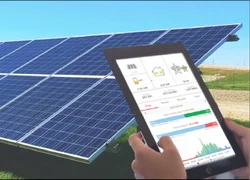Solar energy has rapidly emerged as a sustainable and efficient way to meet our growing energy needs. Designing a solar plant, whether it’s a small rooftop installation or a massive utility-scale facility, requires meticulous planning and attention to detail. A well-designed solar plant not only maximizes energy production but also ensures the long-term viability and return on investment.
In this blog post, we will delve into three crucial elements to check when designing a solar plant, setting you on the path to harnessing clean and renewable energy effectively.
3 Crucial Elements to Check
1. Site Selection and Solar Resource Assessment : One of the primary aspects of designing a solar PV power plant is selecting the right site. The efficiency and productivity of a solar plant heavily depends upon the solar irradiation available at the location. Here are key considerations for site selection:
- Solar Irradiance: Assess the solar irradiance levels at the chosen site. Higher solar irradiance means more sunlight is available for conversion into electricity.
- Shading Analysis: Analyze potential shading issues caused by nearby buildings, trees, or other structures. Shading can significantly reduce the overall energy production of a solar plant.
- Weather Patterns: Consider the local weather patterns and climate conditions. Understanding the seasonal variations and weather extremes is essential for accurate energy production estimates.
Important things to consider while designing a solar plant
Link : https://www.innovationnewsnetwork.com/barriers-to-solar-energy-transition-identified-researchers/38395/
2. System Parameters and Technology Selection : Once the site is selected, the next critical step is designing the solar power plant system. This involves choosing the appropriate technology and components for optimal performance and reliability.
- Solar PV Module Efficiency: Select solar panels with high efficiency to maximize energy production. Monocrystalline and polycrystalline solar panels are common choices, each with its advantages and disadvantages.
- Inverter Efficiency: The inverter is a crucial component that converts DC power generated by solar panels into AC power for grid integration. Choose inverters with high efficiency to minimize energy losses during the conversion process.
3. Regulatory Compliance and Grid Connection : Required approval and grid integration are crucial aspects of solar power plant design. Ensuring compliance with local regulations and seamless integration with the electrical grid are key to the success of the project.
- Permitting and Regulations: Understand and comply with local regulations, permitting processes, and environmental impact assessments. Obtaining the necessary approvals is essential for the smooth implementation of the solar power plant.
- Grid Connection: Ensure that the solar power plant meets the technical and safety requirements specified by the grid operator and should seamlessly integrate with the connected grid.
- Net Metering and Feed-in Tariffs: Explore opportunities for net metering, net billing or feed-in tariffs to enhance the economic viability of the solar power plant. These mechanisms can provide financial incentives and ensure a fair compensation structure for the energy generated.
Conclusion
By carefully selecting the right location, optimizing your system design, and ensuring compliance with local regulations, you can set the stage for a successful and sustainable solar energy project. Solar power not only reduces greenhouse gas emissions but also offers long-term cost savings and energy independence. So, as you embark on your solar plant journey, we at SafEarth can help you as we follow attention to detail and a commitment to excellence that are the key to harnessing the full potential of the sun’s clean and abundant energy.
Join our SafEarth marketplace to explore your options and buy your solar system from qualified installers in your area to make the switch easy and hassle-free.

